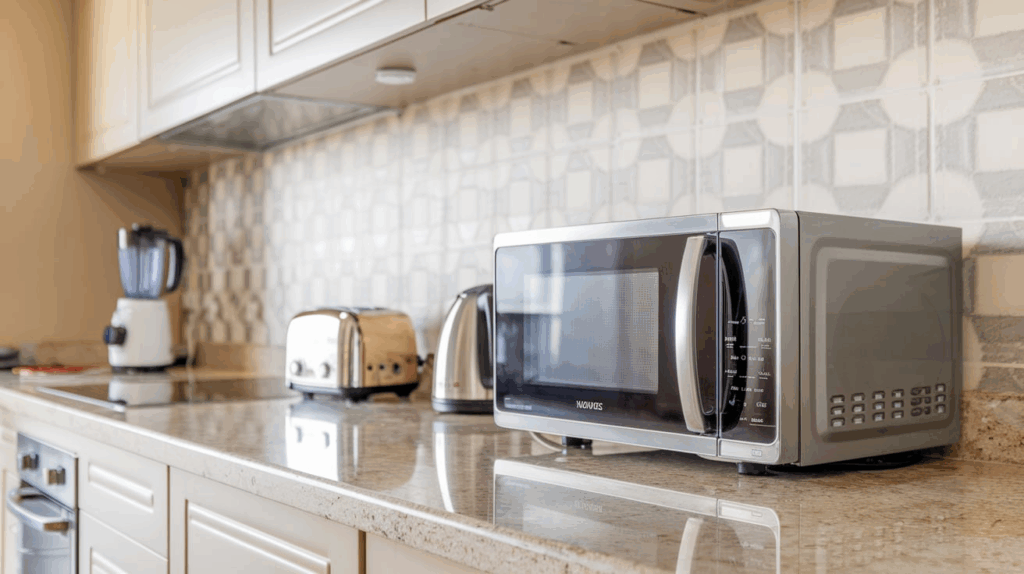
Microwave sparking or arcing can be startling and concerning. If your microwave produces sparks while in use, it’s important to identify and address the issue to keep it safe and functional. Here’s how to troubleshoot and fix the problem.
Why Sparks in a Microwave Shouldn’t Be Ignored
Sparks inside a microwave are more than a visual disturbance—they signal potential hazards that can worsen over time if left unaddressed. Here’s why immediate action is critical:
- Fire Risk: Repeated sparking increases the likelihood of a fire, which could spread beyond the appliance.
- Health Concerns: Sparks may result in smoke or residue that can contaminate your food, affecting its safety.
- Cost of Repairs: What starts as a minor issue can escalate into expensive repairs if vital components are damaged.
- Appliance Longevity: Prompt attention to sparking can prevent further deterioration, helping your microwave last longer.
Signs Your Microwave May Need Replacement
Sometimes, repairing a sparking microwave may not be the best solution. If your microwave shows any of these signs, it might be time for a new appliance:
- Frequent Sparking or Arcing: If the issue persists despite multiple repairs, the appliance may have deeper problems.
- Unusual Noises: Buzzing, humming, or rattling sounds can indicate internal damage.
- Inconsistent Heating: If food heats unevenly or not at all, vital components like the magnetron might be failing.
- Visible Damage: Rust, a deteriorating door seal, or extensive paint chipping can compromise safety.
- Age of the Appliance: Microwaves typically last 7-10 years. If yours is older, a replacement may be more cost-effective than repairs.
Common Causes of Microwave Sparking or Arcing
Sparking, also referred to as arcing, usually happens when:
- Metallic Objects Are Inside: Items like forks, spoons, or aluminum foil reflect microwaves, creating concentrated electromagnetic waves that spark, especially at sharp edges or points.
- Chipped Interior Paint: Exposed metal from chipped paint inside the microwave can result in sparks as microwaves interact with the bare surface.
- Dirty or Damaged Waveguide Cover: A waveguide cover directs microwaves into the cooking chamber. If it’s dirty or damaged, it may cause sparks by creating a pathway for electrical discharge.
- Debris on Interior Walls: Food particles or grease can also act as conduits for sparks when exposed to microwaves.
Is It Safe to Use a Sparking Microwave?
No, a sparking microwave should not be used until the issue is resolved. Continuing to operate a faulty microwave can cause further damage and pose safety risks.
- First Steps: If you notice sparks, immediately turn off and unplug the microwave. Inspect the interior for metal objects, chipped paint, or debris.
Potential Damage Caused by Arcing
Ignoring sparking or arcing can lead to serious damage, including:
- Waveguide Burnout: A damaged waveguide can stop the microwave from functioning correctly.
- Magnetron Damage: The magnetron, which generates microwaves, can fail due to excessive sparking.
- Cavity Damage: The microwave’s interior can sustain permanent damage.
- Electronic Component Failure: Sparks can harm sensitive components such as control boards or sensors.
- Fire Hazards: Severe arcing can lead to fire, posing a significant safety threat.
How to Troubleshoot Sparking or Arcing in a Microwave
Here are the steps to identify and resolve the causes of sparking or arcing in your microwave.
Turn Off and Unplug the Microwave
Start by turning off the microwave and unplugging it from the power source for safety.
Check for Metal Objects
Open the microwave door and inspect the interior for any metal utensils, foil, or other items. Remove any metal objects found.
Inspect and Clean the Waveguide Cover
- Locate the waveguide cover inside the microwave, usually on the right side behind a removable panel.
- Remove the waveguide cover and check for damage such as cracks, burn marks, or warping.
- Clean the waveguide cover if it is dirty.
- Replace the waveguide cover if it is damaged, using a part compatible with your microwave model. Reinstall the cover correctly after cleaning or replacement.
Examine the Interior for Chipped or Exposed Metal
- Inspect the interior of the microwave, focusing on areas near the rack support or turntable.
- If chipped or exposed metal is found, use fine-grit sandpaper to smooth the area.
- Apply a thin, even coat of microwave-safe interior paint over the exposed metal, following the manufacturer’s instructions.
Inspect and Replace the Rack Support if Necessary
- Check the rack support for any damage or exposed metal.
- Refer to the microwave’s manual for instructions on removing the rack support if required.
- Purchase the correct replacement part for your microwave model.
- Install the new rack support securely according to the manufacturer’s guidelines.
Test the Microwave
After completing the repairs or adjustments, plug the microwave back in and test it to confirm the sparking or arcing issue has been resolved.
Final Thoughts
Microwaves are a big help in the kitchen, but sparking is a sign that something’s wrong. Ignoring it could lead to bigger problems like fires, costly repairs, or replacing the appliance entirely. Common causes include metal objects left inside, chipped paint, or a damaged waveguide cover. These are easy to check and fix with some basic steps.
When sparks happen, take action right away. Stop using the microwave and unplug it to avoid further damage. Inspect the inside carefully and address any issues you find, like removing metal utensils or repairing exposed surfaces with microwave-safe paint. If the problem continues, it might be time to consider getting a new microwave, especially if it’s old or showing other signs of wear.
Even small issues can lead to major trouble if left unresolved. Keep an eye out for warning signs, and don’t hesitate to tackle repairs. Acting quickly can save you money, time, and potential safety risks. Next time you see sparks, think of it as your microwave calling for attention—not something to brush off.
